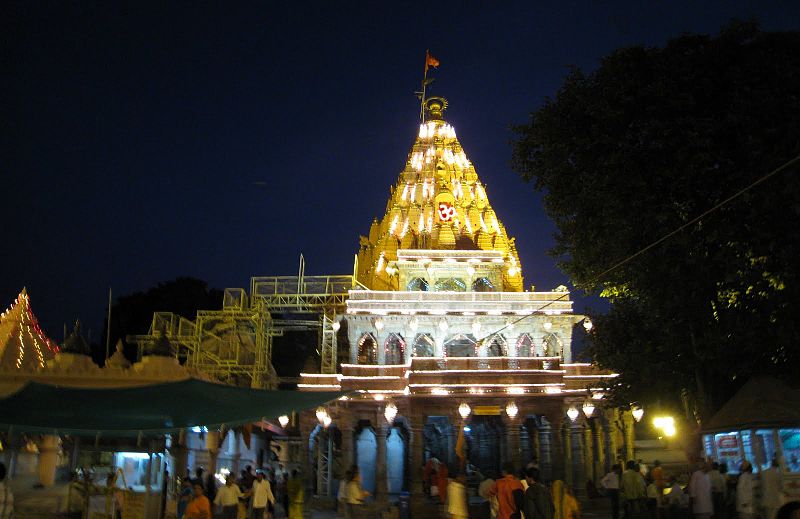There are several reasons why you must love to visit Ujjain, the City of Lord Shiva. The Hindu deity Mahakal is thought to have his eternal abode here. The Mahakaleshwar temple in Ujjain enshrines a self-manifested lingam. It is one of India’s 12 jyotirlinga shrines and here Lord Shiva’s aarti known as Bhasm Aaarti may turn out to be a lifetime experience for you.
Pilgrims and tourists pay a visit to Ujjain for a number of reasons that include abundant spiritual vibes, a wide range of things to do, and reasonably priced accommodations. While Mahakaleshwar Temple in Ujjain is a favourite destination for all kinds of visitors who tour the city, the shrine is frequented by devout Shaivites in large numbers during Mahashivratri and the auspicious month of Shravana when Mahakaleshwar Temple wears a festive look. Ujjain is one place which you should surely visit at least once in your lifetime.
Few people are aware that Mahakaleshwar is also one of the 18 Maha Shakti Peethas, where Sati’s upper lip is said to have fallen and the shakti is called Mahakali. Thus, shiva is worshiped here as Mahakaleshwar and so is the name of the shrine. I visited the revered shrine earlier last month (October) and it turned out to be a satisfying one.
Though it was during vacation (Dussehra time), Ujjain didn’t have too many visitors and thus, the Mahakaleshwar Temple in Ujjain visit was smooth and hassle-free. As I had decided to write this special blog on Mahakaleshwar Jyotirlinga, I visited the shrine three times during my two days stay in Ujjain and explored the temple in detail.
Here, in this post I will talk about everything that you must know about Mahakaleshwar Temple before planning a visit to the shrine.
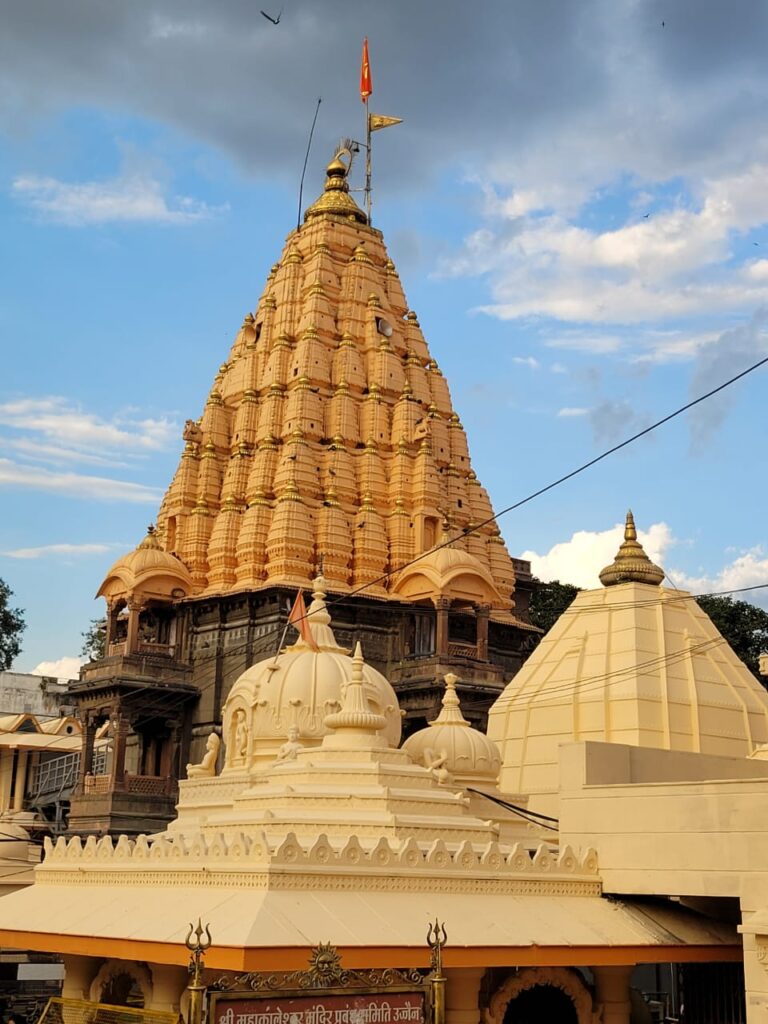
Post Contents
Story of Jyotirlingas
According to Hindu belief, Lord Shiva is the Supreme God and the Creator of the Universe. Legend has it that Lord Brahma and Vishnu ages ago in order to establish supremacy over the other. Shiva appeared in the form of a massive pillar of light in front of them. Brahma went upwards, and Vishnu went downwards, to find the ends of this radiant pillar. Vishnu accepted defeat after failing to find the end, whereas Brahma chose to lie. Shiva emerged from the pillar, cursing Brahma and blessing Vishnu for his piousness. This radiant pillar is known as the ‘Jyotirlinga.’
Thus, the jyotirlinga shrines are locations where Shiva manifested himself as a fiery column of light. Shiva has 64 forms, which should not be confused with Jyotirlingas. Each of the twelve jyotirlinga sites is named after the presiding deity, and is thought to be a different manifestation of Shiva. The primary image at each of these sites is a lingam representing the beginningless and endless Stambha pillar, symbolising Shiva’s infinite nature. The Jyotirlinga in the Ujjain is enshrined as Mahakaleshwar and hence the name of the temple.
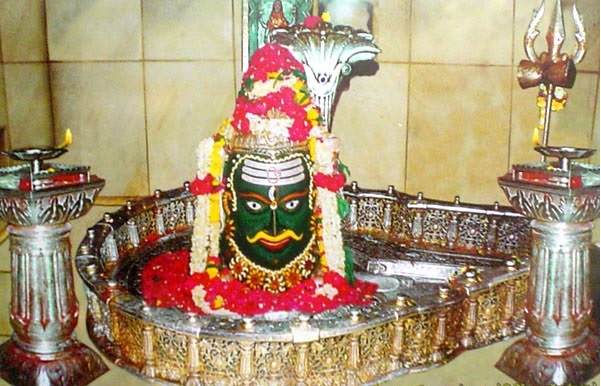
Do Read: Some interesting facts about the Mangalnath Temple of Ujjain
Legend of Mahakaleshwar Temple
Legend has it that King Chandrasena of Ujjain was a devoted follower of Lord Shiva and prayed to him constantly. While praying, he was overheard by Shrikhar, the farmer’s son. The lad wished to join the king in the prayer, but was forcefully removed by palace guards and taken to the outskirts of Ujjain. The boy then overheard rival kings Ripudamana and Singhaditya discussing an attack on Ujjain. He began praying to the Lord immediately to protect his city. When the priest Vridhi heard the news, he began to pray to Lord Shiva on the banks of the river Shipra at the request of his sons.
Ripudamana and Singhaditya attacked Ujjain with the assistance of the demon Dushan and were successful in plundering the city and attacking Lord Shiva’s devotees. Lord Shiv appeared in his mahakal form and defeated Ripudamana and Singhaditya after hearing the priest’s and his devotees’ plea. He agreed to stay in Ujjain to protect the city and his devotees at the behest of Shrikhar and Vridhi. Since then, the Lord has resided in the lingam in his mahakal form, and anyone who worships the lingam is said to be free from death and diseases, as well as blessed by the Lord for the rest of his life.
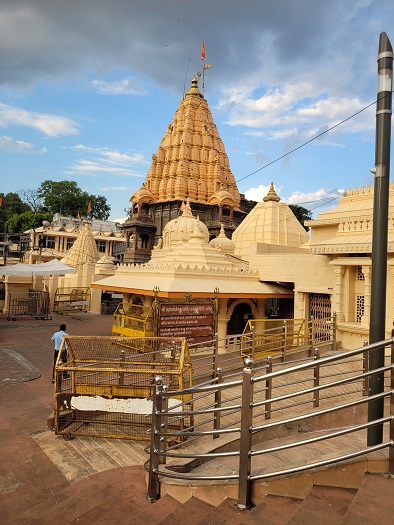
History of Mahakaleshwar Temple
Sultan Shams-ud-din Iltustmish destroyed the temple complex during his raid on Ujjain in 1234-35. The Jyotirlinga was dismantled and is thought to have been thrown into a nearby ‘Kotiteerth Kunda’ (a pond near the temple), while the Jaladhari (a structure supporting the Lingam) was stolen during the invasion.
The existing structure was built in 1734 AD by Maratha general Ranoji Shinde after Baji Rao appointed him to collect taxes in the Malwa region. Other members of the Shinde dynasty worked on further developments and management, including Mahadji Shinde (1730-1794) and Daulat Rao Shinde’s wife Baiza Bai (1827–1863). Major programs of the then Gwalior State used to be held at this temple during the reign of Jayajirao Shinde until 1886.
In the fourth decade of the 18th century, the Maratha Empire regime was established in Ujjain. Peshwa Bajirao-I entrusted the administration of Ujjain to his faithful commander Ranoji Shinde. The Diwan of Ranoji was Sukhatanakar Ramchandra Baba Shenavi, who was very wealthy and decided to invest his wealth for religious purposes. In this respect, he rebuilt the Mahakaleshwar Temple in Ujjain in the fourth and fifth decades of the 18th century.
The Mahakaleshwar Devasthan Trust was taken over by the municipal corporation of Ujjain after India achieved independence in 1947. It is now administered by the collectorate office of the Ujjain district.
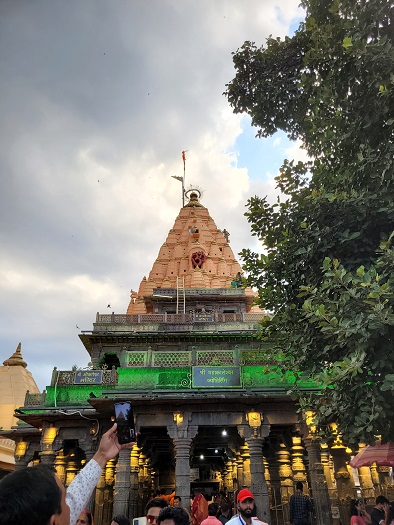
You may also like: 5 top places to visit near Badrinath
Mahakaleshwar Temple Complex
As you enter the Mahakaleshwar temple complex, you find the shrine is a stunning and artistic blend of Maratha, Bhumija, and Chalukya architectural styles. The temple, situated close to Rudra Sagar lake and set upon a spacious courtyard surrounded by massive walls, has five levels in total, one of which is underground. The colossal idol of Mahakaleshwar is located below ground level (Garbhagriha) and is a Dakshina-murti, which means it faces south.
Omkareswara and Nagachandreswara lingams are installed in the temple’s middle and uppermost parts, respectively. Only on Nag Panchami day is the idol of Nagachandreswara accessible for public viewing. A large Kunda, known as Koti Tirtha, can also be found in the compound and is considered sacred.
A huge veranda to the east of this Kunda serves as the entrance to the path leading to the Garbhagrha, where small-sized images of Ganesha, Kartikeya, and Parvati can also be found. The esoteric silver-plate covering the roof of the Garbhagriha adds to the shrine’s grandeur. Classical eulogies to Lord Shiva are depicted all around the walls. The images of Sri Rama and the goddess Avantika are worshiped in a cell on the veranda’s northern side.
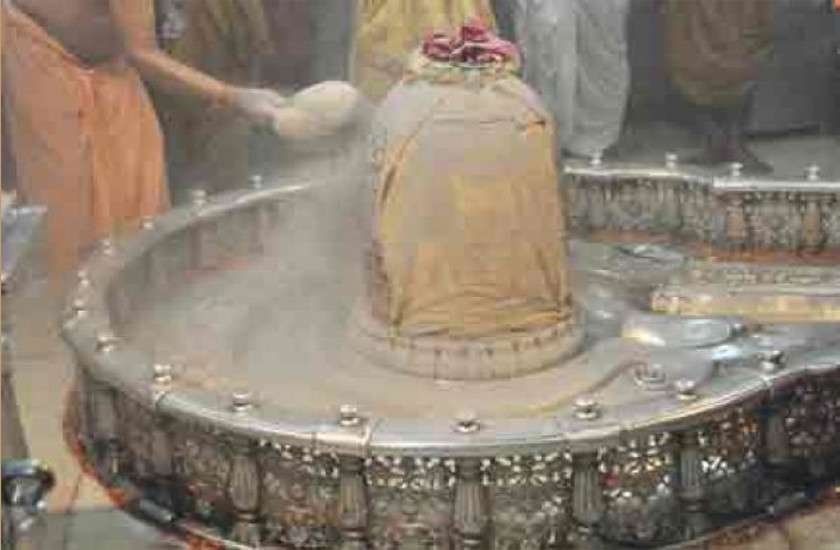
The Spectacular Bhasm-Aarti at Mahakaleshwar Temple
While visiting Mahakaleshwar Temple in Ujjain, make sure not to miss the mesmerising Bhasm-Aarti that takes place everyday before dawn. This daily ritual is performed early in the morning to pay obeisance to Lord Mahakaleshewar, the presiding deity of the temple. Bhasma Aarti is a special kind of aarti that is performed during the Brahma Muhurat (about two hours before sunrise) in the temple where the priests offer holy ash (Bhasma) to the deity while chanting sacred mantras. The aarti generates vibrations that make devotees feel the presence of the divine in front of them.
Bhasma, or sacred ash, is offered to Shiva because he is commonly associated with Kaal, or death. He is the only one who has authority over Kaal. Moreover, once burned, everything is reduced to ash. Nothing else remains. As a result, it is unavoidable. Ash serves as a constant reminder that we are all made of the same elements. Thus, the sacred ash is applied to Lord Shiva, who is quite often seen meditating with Bhasma all over his body.
Unlike the sacred ash found in most temples, the Mahakal bhasm arti in the past required chita bhasm or ash from the first funeral pyre cremated at night. Today, the practice has changed and temple officials prepare fresh ash from cow dung and present it in a thin cloth pouch.It is recommended to stay in at the temple itself, or at a nearby hotel so that you get a chance to witness the mesmerising Bhasm-Aarti.
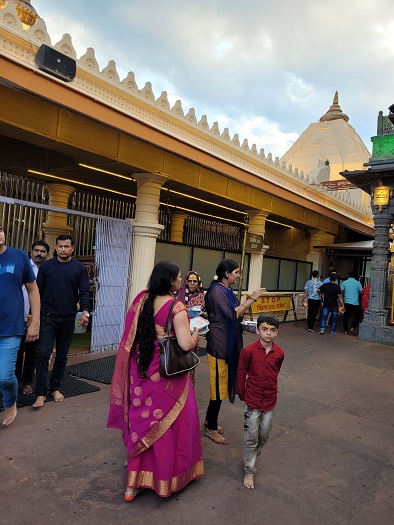
Also Read: All You Need To Know About Badrinath Dham
How to do Bhasm-Aarti booking?
To take part in this divine aarti, you need to have an offline or online booking.However through this post, I will simplify your job to a large extent.
Now, those who are local people of Ujjain have both the option and they can book online from the website of temple administration or get offline booking from the counter just outside the temple complex. For outsiders, online booking is the best option.
To book for Bhasm=Aarti online, you need to visit the Mahakaleshwar Temple website https://shrimahakaleshwar.com/. From here choose the Bhasm Aarti tab and then select Bhasm Aarti online booking from the dropdown list. A page will appear before you that displays the number of available slots with dates. First note if a slot is available on a particular date and then click the date. You can book up to five slots at a time. A form will be displayed and you just need to enter your credentials and upload photo and ID proof.
All those who have booked the Bhasm Aarti must have their photographs and an ID proof. It is mandatory for women to wear a saari to attend the Mahakaleshwar Bhasma Aarti, while men have to wear a dhoti. You can keep items like mobile, belt etc. in your hotel room or deposit it in the temple premises itself because you cannot take these items inside.
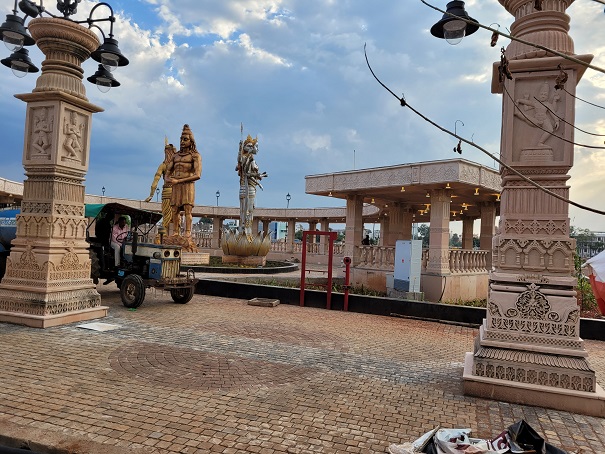
Festivals at Mahakaleshwar Temple In Ujjain
All rituals, including Puja-Archana and Abhishekaarati, are performed on a regular basis in the temple throughout the year. The main festivals observed here are:
1. Nitya Yatra: In this ritual, the pilgrims take a bath in the holy Shipra before visiting Nagachandreswara, Koteswara, Mahakaleshwar, goddess Avantika, goddess Harasiddhi, and Agastheswara for Darshan.
2. Sawari (Procession): Every Monday for a specific time period, the sacred procession of Lord Shiva passes through the streets of Ujjain. The last Sawari, which takes place during the dark fortnight of Bhadrapada, attracts the attention of lakhs of people and is celebrated with great pomp and show. The procession during the Vijayadashami festival is equally exciting and enticing.
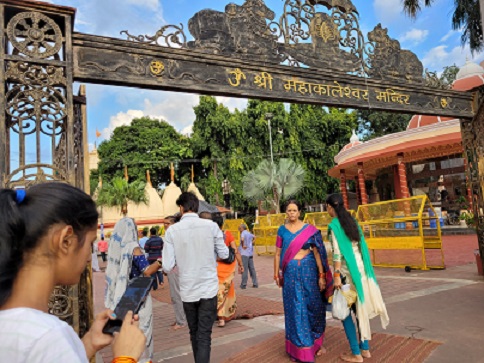
Must Read: Visiting Taratarini Temple, the Adi Shakti Peetha in Odisha
Frequently Asked Questions About Mahakaleshwar Temple In Ujjain
According to Hindu mythology, the Mahakaleshwar temple in Ujjain is built by Lord Brahma. However, the temple structure suggests that the temple was built midway through the 18th century in Bhumija, Chalukya, and Maratha styles of architecture.
The nearest airport to Mahakaleshwar temple is located in Indore which is 51 km away and the nearest railway station is Ujjain JUnction which is 1.5 km from the temple.Ujjain is also well connected by road to most places of Madhya Pradesh and neighbouring states.
The best time to visit Mahakaleshwar temple in Ujjain is from October through March.
The darshan in Mahakaleshwar temple in Ujjain doesn’t take much time. It is usually over in 30 minutes to 1 hour. So, never go for the VIP or the Shighra Darshan unless you are visiting in the month of Sravana or a festival day like Maha Shivaratri.

